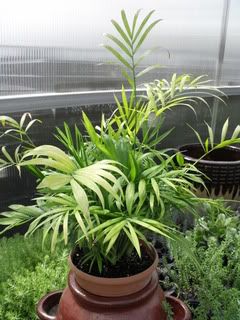Parlor Palm

The Parlor Palm is one of the easiest-to-find plants in the United States. It is sold at many garden centers in the south as an outdoor plant but you’re just as likely to see it sold alongside the houseplants. The scientific name for the Parlor Palm is Chamaedora elegans, though it is sometimes listed as Neanthe Bella or Bella Palm.
 Parlor Palms like light, but direct sun isn’t necessary. Filtered or diffuse light is best. These plants will also survive in shady areas and so they are a great choice for not just the home, but the office as well.
Parlor Palms like light, but direct sun isn’t necessary. Filtered or diffuse light is best. These plants will also survive in shady areas and so they are a great choice for not just the home, but the office as well.
To prevent fronds from dying back, keep the plant watered evenly. Check the potting mix every few days until you become comfortable with the plant’s requirements. Plants in small pots can be watered when the surface of the potting mix is dry. Larger specimens should be allowed to dry out half an inch to an inch down. Make sure that the potting mix is moistened well and allow any excess water to drain off. Humidity isn’t incredibly important to this plant, making it a good choice for drier environments.
Parlor Palms do not need much fertilizer, but some is definitely good. Use a water-soluble fertilizer once a month during the spring, summer and fall. None is needed during the winter when the plant’s growth will slow down. If a white crust builds up on the pot, around drainage holes or on the soil surface, the plant is likely receiving too much fertilizer. Cut back by half and flush the pot thoroughly with clear water at the next watering.
Propagation of Parlor Palms is usually done from seed, though division is sometimes done as well. The plant will experience shock if it is divided; many of the outer fronds may die back and it will recover slowly. Leaf cuttings are another reported way that this plant can be propagated, but from my experience with this plant I doubt that it has a very high success rate.
Occasionally, pests can be a problem. Scale, mealy bugs and spider mites all enjoy making a home on Parlor Palms. A quick check at every watering will ensure that you catch an infestation in its early stages, making it much easier to treat.
Parlor Palms grow extremely slowly. Keep that in mind when you are shopping for one. If you want a large specimen, buy a large specimen. Small plants will remain small for an incredibly long time, taking more than a decade to reach two or three feet tall. This fact makes Parlor Palms a great addition to terrariums, dish gardens and interiorscaping.

To prevent fronds from dying back, keep the plant watered evenly. Check the potting mix every few days until you become comfortable with the plant’s requirements. Plants in small pots can be watered when the surface of the potting mix is dry. Larger specimens should be allowed to dry out half an inch to an inch down. Make sure that the potting mix is moistened well and allow any excess water to drain off. Humidity isn’t incredibly important to this plant, making it a good choice for drier environments.
Parlor Palms do not need much fertilizer, but some is definitely good. Use a water-soluble fertilizer once a month during the spring, summer and fall. None is needed during the winter when the plant’s growth will slow down. If a white crust builds up on the pot, around drainage holes or on the soil surface, the plant is likely receiving too much fertilizer. Cut back by half and flush the pot thoroughly with clear water at the next watering.
Propagation of Parlor Palms is usually done from seed, though division is sometimes done as well. The plant will experience shock if it is divided; many of the outer fronds may die back and it will recover slowly. Leaf cuttings are another reported way that this plant can be propagated, but from my experience with this plant I doubt that it has a very high success rate.
Occasionally, pests can be a problem. Scale, mealy bugs and spider mites all enjoy making a home on Parlor Palms. A quick check at every watering will ensure that you catch an infestation in its early stages, making it much easier to treat.
Parlor Palms grow extremely slowly. Keep that in mind when you are shopping for one. If you want a large specimen, buy a large specimen. Small plants will remain small for an incredibly long time, taking more than a decade to reach two or three feet tall. This fact makes Parlor Palms a great addition to terrariums, dish gardens and interiorscaping.
This site needs an editor - click to learn more!
You Should Also Read:
Spider Mites
Plants for Dark Corners
Houseplants Newsletter
Related Articles
Editor's Picks Articles
Top Ten Articles
Previous Features
Site Map
Content copyright © 2023 by Lisa Beth Voldeck. All rights reserved.
This content was written by Lisa Beth Voldeck. If you wish to use this content in any manner, you need written permission. Contact
BellaOnline Administration
for details.


